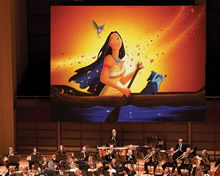With cellist Barbara Blaker Krumdieck taking over as artistic director from harpsichordist Henry Lebedinsky, Music at St. Alban’s launched its eighth season at the Episcopal Church in Davidson with BachFest VI. If instrumentation and musical selections are a reliable indication, the new artistic director has her own ideas about what the festival should look and sound like. Gone were the wind instruments and the harpsichord that surrounded the string choir last year, replaced by an organ – playing both solo and continuo roles – and a 19-string archlute. Krumdieck also replaced the composers who shared the bill with Johann Sebastian, presenting works by Heinrich Biber, Arcangelo Corelli, Georg Muffat, and Antonio Vivaldi.
Leading off, Sonata 1 from Biber’s Fidicinium Sacro-profanum was a fascinating eight-part labyrinth that sported even more tempo changes than that, but they were all gracefully intertwined by violinist David Wilson, playing with the full range of instruments behind him. Particularly notable was the rich continuo provided by Krumdieck, organist John O’Brien, and a swollen six-string double bass played by Robbie Link. Their admirable pulse, it must be confessed, made my attempts to hear what Dan Smith was playing on his archlute completely futile, but the ensemble and the piece were far too delicious to find fault with.
O’Brien, a piano professor at Eastern Carolina University, didn’t travel all the way from Greenville with his portable instrument just to plink a set of continuos. He came to the front to introduce a Bach concerto – rightfully so, since there are no organ concertos in the mighty BWV catalog. This concerto was cobbled together with two sinfonias extracted from Bach’s Cantata 35 and, in between those two fast movements, an arrangement of the famed “Air on a G String” for an ensemble of nine, one more violin than for the Biber. Yet the difference seemed larger than that when O’Brien held forth in the virtuosic solos of the sinfonias, switching from the solemn timbre of the opening sonata to a sweet fruity lyricism. The middle Adagio, on the other hand, was so quiet that the sound of Smith’s archlute glimmered underneath the organ, the only time during the concert that its presence truly counted.
The arioso may have upstaged the surrounding sinfonias, but the makeshift concerto was a hard act to follow. Corelli’s Opus 6/4 Concerto Grosso in D, with its briskly-paced dialogues between the violins and the remainder of the ensemble, was a well-chosen sequel to O’Brien’s organ exploits. Only when the opening Adagio-Allegro gave way to an Adagio did the Corelli work seem rather leaden by comparison – like a meditative interlude at church. But there were three sections afterwards, with sparkling work from violinists Wilson and John Pruett, to bring us back on track before intermission.
With Wilson returning to the first violin stand, Muffat’s Sonata V from his Armonico Tributo proved to be an unexpected treat, richer in its adagio harmonies than the Corelli if not nearly as technically challenging. There didn’t seem to be any fast movements in the piece as I noticed the grave marking of the outer movements in my program, and the Fuga between the two adagios hardly broke into a trot. The performance was anything but dreary, however, as those outer movements were rendered at a more andante pace. Then toward the end of the concluding Passacaglia (marked grave), after charmingly unfolding in a leisurely 3/4 tempo with a hypnotic Pachelbel Canon effect, a two-stage acceleration broke out before the piece came to a satisfying rest.
The last two concertos took us back to mainstream repertoire, beginning with a Vivaldi violin concerto lazily labeled as the B flat – at least four different concertos in this key have been recorded, and the Allegro-Adagio-Allegro tempo sequence hardly helped to differentiate this one. Gesa Kordes stepped up to introduce the piece and play the first violin part. Her abrasive timbre sharply contrasted with Wilson’s more honeyed tone, but when you think of the sawing that typically occurs in Vivaldi’s violin writing – or in Corelli’s, for that matter – Kordes’ rusticated tone was not a bad thing. Her double-stopping was very flavorful launching the opening Allegro, and after some intonation and articulation problems a page or two later, Kordes seemed to relax and find her stride. The Adagio placed her attractively in a trio setting with Krumdieck and O’Brien, and the closing Allegro – accelerating from a cantering pace to a frothing gallop – seemed the most recognizably Vivaldian movement of all.
The Bach Violin Concerto in A minor concluded the festival with Wilson once again taking the solos and lavishing all the sweetness of his tone on the brisk opening movement. Some beautiful dialogue between the soloist and the continuo players adorned the middle Andante before Wilson showered some valedictory virtuosity on the Allegro assai. More polite than the raging elements outside, the audience waited for Wilson and the ensemble to finish before thundering their approval.











